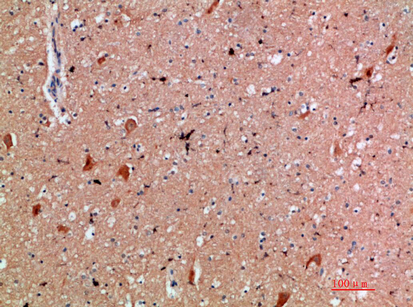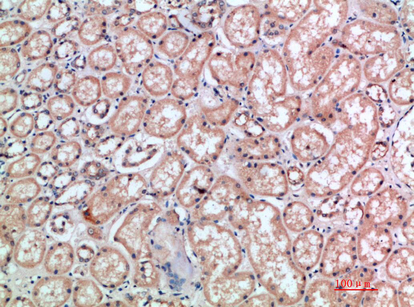

| WB | 咨询技术 | Human,Mouse,Rat |
| IF | 咨询技术 | Human,Mouse,Rat |
| IHC | 1/50-300 | Human,Mouse,Rat |
| ICC | 技术咨询 | Human,Mouse,Rat |
| FCM | 咨询技术 | Human,Mouse,Rat |
| Elisa | 咨询技术 | Human,Mouse,Rat |
| Aliases | CMRF35-like molecule 2 (CLM-2) (CD300 antigen-like family member E) (CMRF35-A5) (Immune receptor expressed on myeloid cells 2) (IREM-2) (Polymeric immunoglobulin receptor 2) (PIgR-2) (PIgR2) (Poly-Ig receptor 2) (CD antigen CD300e) |
| Entrez GeneID | 342510; |
| Host/Isotype | Rabbit IgG |
| Antibody Type | Primary antibody |
| Storage | Store at 4°C short term. Aliquot and store at -20°C long term. Avoid freeze/thaw cycles. |
| Species Reactivity | Human |
| Immunogen | Synthetic peptide from human protein at AA range: 31-80 |
| Formulation | Purified antibody in PBS with 0.05% sodium azide,0.5%BSA and 50% glycerol. |
+ +
以下是关于CD300e抗体的3篇代表性文献及其摘要概述:
---
1. **文献名称**:*CD300e modulates neutrophil inflammatory response via regulating lipid raft formation*
**作者**:Martínez-Barriocanal et al.
**摘要**:该研究揭示了CD300e在调控中性粒细胞炎症反应中的作用,发现其通过促进脂筏(lipid raft)的形成激活下游信号通路,影响中性粒细胞的迁移和炎症因子释放,为靶向CD300e治疗过度炎症提供了依据。
---
2. **文献名称**:*Structural basis of CD300e recognition by a therapeutic antibody in autoimmune diseases*
**作者**:Li et al.
**摘要**:本研究解析了CD300e蛋白的晶体结构,并报道了一种特异性抗体与CD300e胞外域的相互作用机制。实验证明该抗体可阻断CD300e介导的促炎信号,在自身免疫病模型中显示出治疗潜力。
---
3. **文献名称**:*CD300e acts as a co-receptor for TLR4 in sepsis pathogenesis*
**作者**:Suzuki et al.
**摘要**:研究发现CD300e在脓毒症中通过与TLR4形成复合物增强巨噬细胞的炎症反应,使用抗CD300e抗体可显著减轻小鼠模型的脓毒症症状,表明其作为脓毒症治疗靶点的可能性。
---
如需具体文献来源或补充更多研究,可进一步提供检索方向。
CD300e, a member of the CD300 family of immunoregulatory cell-surface proteins, is a transmembrane glycoprotein expressed primarily on myeloid cells such as monocytes, macrophages, and dendritic cells. It plays a role in modulating immune responses by integrating activating and inhibitory signals, though its precise biological functions remain under investigation. Structurally, CD300e contains an immunoglobulin (Ig)-like domain and interacts with ligands such as phosphatidylserine and other phospholipids, which are exposed on stressed or apoptotic cells. This interaction suggests its involvement in processes like phagocytosis, inflammation, and pathogen sensing.
CD300e antibodies, either monoclonal or polyclonal, are critical tools for studying the receptor's expression, ligand binding, and signaling pathways. They have been utilized to explore its role in immune regulation, particularly in contexts like sepsis, cancer, and autoimmune diseases. For example, studies suggest CD300e may influence cytokine production and cell survival, making it a potential therapeutic target. However, its dual role in pro- and anti-inflammatory responses complicates therapeutic strategies.
Current research focuses on clarifying CD300e's mechanistic contributions to immunity and its interplay with other CD300 family members. While clinical applications remain exploratory, CD300e antibodies hold promise for diagnostics and immune-modulating therapies, pending further validation of their functional impacts and safety profiles.
×